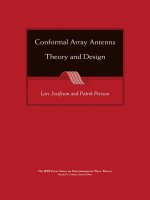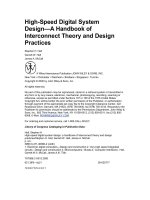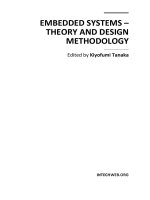- Trang chủ >>
- Khoa Học Tự Nhiên >>
- Vật lý
Conformal array antenna theory and design josefsson, persson
Bạn đang xem bản rút gọn của tài liệu. Xem và tải ngay bản đầy đủ của tài liệu tại đây (12.4 MB, 488 trang )
CONFORMAL ARRAY
ANTENNA THEORY
AND DESIGN
Lars Josefsson
Chalmers University of Technology, Sweden
Patrik Persson
Royal Institute of Technology, Sweden
IEEE Antennas and Propagation Society,
Sponsor
A WILEY-INTERSCIENCE PUBLICATION
IEEE Press
ffirs.qxd 2/2/2006 3:49 PM Page iii
CONFORMAL ARRAY
ANTENNA THEORY
AND DESIGN
ffirs.qxd 2/2/2006 3:49 PM Page i
IEEE Press
445 Hoes Lane
Piscataway, NJ 08854
IEEE Press Editorial Board
Mohamed E. El-Hawary, Editor in Chief
M. Akay T. G. Croda M. S. Newman
J. B. Anderson R.J. Herrick F. M. B. Pereira
R. J. Baker S. V. Kartalopoulos C. Singh
J. E. Brewer M. Montrose G. Zobrist
Kenneth Moore, Director of IEEE Book and Information Services (BIS)
Catherine Faduska, Senior Acquisitions Editor
IEEE PRESS SERIES ON ELECTROMAGNETIC WAVE THEORY
The IEEE Press Series on Electromagnetic Wave Theory consists of new titles as well as reprints
ahd revisions of recognized classics in electromagnetic waves and applications which maintain
long-term archival significance.
Series Editor
Donald G. Dudley
University of Arizona
Advisory Board
Robert B. Collin Akira Ishimaru D. S. Jones
Case Western Reserve University of Washington University of Dundee
University
Associate Editors
E
LECTROMAGNETIC
T
HEORY
, S
CATTERING
,I
NTEGRAL
E
QUATION
M
ETHODS
AND
D
IFFRACTION
Donald R. Wilton
Ehud Heyman University of Houston
Tel-Aviv University
BOOKS IN THE IEEE PRESS SERIES
ON ELECTROMAGNETIC WAVE THEORY
Christopoulos, C., The Transmission-Line Modeling Methods, TLM
Clemmow, P. C., The Plane Wave Spectrum Representation of Electromagnetic Fields
Collin, R. B., Field Theory of Guided Waves, Second Edition
Dudley, D. G., Mathematical Foundations for Microwave Engineering, Second Edition
Elliot, R. S., Antenna Theory and Design, Revised Edition
Elliot, R. S., Electromagnetics: History Theory, and Applications
Felsen, L. B., and Marcuvitz, N., Radiation and Scattering of Waves
Harrington, R. F, Field Computation of Moment Methods
Harrington, R. F, Time Harmonic Electromagnetic Fields
Hansen et al., Plane-Wave Theory of Time-Domain Fields. Near-Field Scanning Applications
Ishimaru, A., Wave Propagation and Scattering in Random Media
Jones, D. S., Methods in Electromagnetic Wave Propagation, Second Edition
Lindell, I. V., Methods for Electromagnetic Field Analysis
Lindell, I. V, Differential Forms in Electromagnetics
Peterson et al., Computational Methods for Electromagnetics
Tai, C. T., Generalized Vector and Dyadic Analysis. Applied Mathematics in Field Theory
Tai, C. T., Dyadic Green Functions in Electromagnetic Theory, Second Edition
Van Bladel, J., Singular Electromagnetic Fields and Sources
Volakis et al., Finite Element Method. for Electromagnetics: Antennas, Microwave Circuits, and
Scattering Applications
Wait, J., Electromagnetic Waves in Stratified Media
ffirs.qxd 2/2/2006 3:49 PM Page ii
CONFORMAL ARRAY
ANTENNA THEORY
AND DESIGN
Lars Josefsson
Chalmers University of Technology, Sweden
Patrik Persson
Royal Institute of Technology, Sweden
IEEE Antennas and Propagation Society,
Sponsor
A WILEY-INTERSCIENCE PUBLICATION
IEEE Press
ffirs.qxd 2/2/2006 3:49 PM Page iii
Copyright © 2006 by the Institute of Electrical and Electronics Engineers, Inc. All rights reserved.
Published by John Wiley & Sons, Inc., Hoboken, New Jersey.
Published simultaneously in Canada.
No part of this publication may be reproduced, stored in a retrieval system, or transmitted in any form or by
any means, electronic, mechanical, photocopying, recording, scanning, or otherwise, except as permitted under
Section 107 or 108 of the 1976 United States Copyright Act, without either the prior written permission of the
Publisher, or authorization through payment of the appropriate per-copy fee to the Copyright Clearance Center,
Inc., 222 Rosewood Drive, Danvers, MA 01923, (978) 750-8400, fax (978) 750-4470, or on the web at
Department, John Wiley & Sons, Inc., 111 River Street, Hoboken, NJ 07030, (201) 748-6011, fax (201) 748-
6008, or online at />Limit of Liability/Disclaimer of Warranty: While the publisher and author have used their best efforts in
preparing this book, they make no representations or warranties with respect to the accuracy or completeness of
the contents of this book and specifically disclaim any implied warranties of merchantability or fitness for a
particular purpose. No warranty may be created or extended by sales representatives or written sales materials.
The advice and strategies contained herein may not be suitable for your situation. You should consult with a
professional where appropriate. Neither the publisher nor author shall be liable for any loss of profit or any
other commercial damages, including but not limited to special, incidental, consequential, or other damages.
For general information on our other products and services or for technical support, please contact our
Customer Care Department within the United States at (800) 762-2974, outside the United States at (317) 572-
3993 or fax (317) 572-4002.
Wiley also publishes its books in a variety of electronic formats. Some content that appears in print may not be
available in electronic format. For information about Wiley products, visit our web site at www.wiley.com.
Library of Congress Cataloging-in-Publication Data is available.
ISBN-13 978-0-471-46584-3
ISBN-10 0-471-46584-4
Printed in the United States of America.
10987654321
ffirs.qxd 2/2/2006 3:49 PM Page iv
www.copyright.com. Requests to the Publisher for permission should be addressed to the Permissions
Preface xi
Abbreviations and Acronyms xiii
1 INTRODUCTION 1
1.1 The Definition of a Conformal Antenna 1
1.2 Why Conformal Antennas? 2
1.3 History 4
1.4 Metal Radomes 9
1.5 Sonar Arrays 9
References 11
2 CIRCULAR ARRAY THEORY 15
2.1 Introduction 15
2.2 Fundamentals 16
2.2.1 Linear Arrays 16
2.2.2 Circular Arrays 19
2.3 Phase Mode Theory 23
2.3.1 Introduction 23
2.3.2 Discrete Elements 27
2.3.3 Directional Elements 29
2.4 The Ripple Problem in Omnidirectional Patterns 34
2.4.1 Isotropic Radiators 37
2.4.2 Higher-Order Phase Modes 40
2.4.3 Directional Radiators 40
2.5 Elevation Pattern 41
2.6 Focused Beam Pattern 41
References 46
3 THE SHAPES OF CONFORMAL ANTENNAS 49
3.1 Introduction 49
3.2 360° Coverage 52
v
CONTENTS
ftoc.qxd 2/2/2006 3:51 PM Page v
3.2.1 360° Coverage Using Planar Surfaces 52
3.2.2 360° Coverage Using a Curved Surface 54
3.3 Hemispherical Coverage 57
3.3.1 Introduction 57
3.3.2 Hemispherical Coverage Using Planar Surfaces 58
3.3.3 Half Sphere 60
3.3.4 Cone 60
3.3.5 Ellipsoid 62
3.3.6 Paraboloid 63
3.3.7 Comparing Shapes 64
3.4 Multifaceted Surfaces 67
3.5 References 70
4 METHODS OF ANALYSIS 73
4.1 Introduction 73
4.2 The Problem 75
4.3 Electrically Small Surfaces 76
4.3.1 Introduction 76
4.3.2 Modal Solutions 76
4.3.2.1 Introduction 76
4.3.2.2 The Circular Cylinder 77
4.3.2.3 A Unit Cell Approach 79
4.3.3 Integral Equations and the Method of Moments 80
4.3.4 Finite Difference Time Domain Methods (FDTD) 81
4.3.4.1 Introduction 81
4.3.4.2 Conformal or Contour-Patch (CP) FDTD 82
4.3.4.3 FDTD in Global Curvilinear Coordinates 83
4.3.4.4 FDTD in Cylindrical Coordinates 84
4.3.5 Finite Element Method (FEM) 87
4.3.5.1 Introduction 87
4.3.5.2 Hybrid FE-BI Method 88
4.4 Electrically Large Surfaces 89
4.4.1 Introduction 89
4.4.2 High-Frequency Methods for PEC Surfaces 90
4.4.3 High-Frequency Methods for Dielectric Coated Surfaces 93
4.5 Two Examples 95
4.5.1 Introduction 95
4.5.2 The Aperture Antenna 95
4.5.3 The Microstrip-Patch Antenna 98
4.6 A Comparison of Analysis Methods 100
Appendix 4A—Interpretation of the ray theory 100
4A.1 Watson Transformation 103
4A.2 Fock Substitution 103
4A.3 SDP Integration 104
4A.4 Surface Waves 105
4A.5 Generalization 107
References 108
vi
CONTENTS
ftoc.qxd 2/2/2006 3:51 PM Page vi
5 GEODESICS ON CURVED SURFACES 123
5.1 Introduction 123
5.1.1 Definition of a Surface and Related Parameters 125
5.1.2 The Geodesic Equation 127
5.1.3 Solving the Geodesic Equation and the Existence of Geodesics 128
5.2 Singly Curved Surfaces 130
5.3 Doubly Curved Surfaces 135
5.3.1 Introduction 135
5.3.2 The Cone 135
5.3.3 Rotationally Symmetric Doubly Curved Surfaces 137
5.3.4 Properties of Geodesics on Doubly Curved Surfaces 139
5.3.5 Geodesic Splitting 141
5.4 Arbitrarily Shaped Surfaces 149
5.4.1 Hybrid surfaces 150
5.4.2 Analytically Described Surfaces 152
References 152
6 ANTENNAS ON SINGLY CURVED SURFACES 155
6.1 Introduction 155
6.2 Aperture Antennas on Circular Cylinders 157
6.2.1 Introduction 157
6.2.2 Theory 157
6.2.3 Mutual Coupling 158
6.2.3.1 Isolated Mutual Coupling 158
6.2.3.2 Cross Polarization Coupling 168
6.2.3.3 Array mutual coupling 168
6.2.4 Radiation Characteristics 173
6.2.4.1 Isolated-Element Patterns 175
6.2.4.2 Embedded-Element Patterns 176
6.3 Aperture Antennas on General Convex Cylinders 192
6.3.1 Introduction 192
6.3.2 Mutual Coupling 193
6.3.2.1 The Elliptic Cylinder 193
6.3.2.2 The Parabolic Cylinder 194
6.3.2.3 The Hyperbolic Cylinder 194
6.3.3 Radiation Characteristics 194
6.3.3.1 The Elliptic Cylinder 196
6.3.3.2 End Effects 196
6.4 Aperture Antennas on Faceted Cylinders 200
6.4.1 Introduction 200
6.4.2 Mutual Coupling 207
6.4.3 Radiation Characteristics 209
6.5 Aperture Antennas on Dielectric Coated Circular Cylinders 209
6.5.1 Introduction 209
6.5.2 Mutual Coupling 213
6.5.2.1 Isolated Mutual Coupling 213
6.5.2.2 Array Mutual Coupling 215
6.5.3 Radiation Characteristics 221
CONTENTS
vii
ftoc.qxd 2/2/2006 3:51 PM Page vii
6.5.3.1 Isolated-Element Patterns 221
6.5.3.2 Embedded-Element Patterns 223
6.6 Microstrip-Patch Antennas on Coated Circular Cylinders 230
6.6.1 Introduction 230
6.6.2 Theory 231
6.6.3 Mutual Coupling 232
6.6.3.1 Single-Element Characteristics 232
6.6.3.2 Isolated and Array Mutual Coupling 232
6.6.4 Radiation Characteristics 237
6.6.4.1 Isolated-Element Patterns 237
6.6.4.2 Embedded-Element Patterns 238
6.7 The Cone 245
6.7.1 Introduction 245
6.7.2 Mutual Coupling 246
6.7.2.1 Aperture Antennas 246
6.7.2.2 Microstrip-Patch Antennas 247
6.7.3 Radiation Characteristics 248
6.7.3.1 Aperture Antennas 248
6.7.3.2 Microstrip-Patch Antennas 257
References 258
7 ANTENNAS ON DOUBLY CURVED SURFACES 265
7.1 Introduction 265
7.2 Aperture Antennas 267
7.2.1 Introduction 267
7.2.2 Mutual Coupling 267
7.2.2.1 Isolated Mutual Coupling 269
7.2.2.2 Array Mutual Coupling 282
7.2.3 Radiation Characteristics 283
7.3 Microstrip-Patch Antennas 289
7.3.1 Introduction 289
7.3.2 Mutual Coupling 289
7.3.2.1 Single-Element Characteristics 291
7.3.2.2 Isolated Mutual Coupling 294
7.3.3 Radiation Characteristics 297
References 302
8 CONFORMAL ARRAY CHARACTERISTICS 305
8.1 Introduction 305
8.2 Mechanical Considerations 306
8.2.1 Array Shapes 306
8.2.2 Element Distribution on a Curved Surface 308
8.2.3 Multifacet Solutions 308
8.2.4 Tile Architecture 309
8.2.5 Static and Dynamic Stress 312
8.2.6 Other Electromagnetic Considerations 312
8.3 Radiation Patterns 313
8.3.1 Introduction 313
viii
CONTENTS
ftoc.qxd 2/2/2006 3:51 PM Page viii
8.3.2 Grating Lobes 315
8.3.3 Scan-Invariant Pattern 319
8.3.4 Phase-Scanned Pattern 319
8.3.5 A Simple Aperture Model for Microstrip Arrays 323
8.4 Array Impedance 327
8.4.1 Introduction 327
8.4.2 Phase-Mode Impedance 330
8.5 Polarization 336
8.5.1 Polarization Definitions 336
8.5.2 Cylindrical Arrays 337
8.5.2.1 Dipole Elements 337
8.5.2.2 Aperture elements 337
8.5.3 Polarization in Doubly Curved Arrays 340
8.5.3.1 A Paraboloidal Array 341
8.5.4 Polarization Control 348
8.6 Characteristics of Selected Conformal Arrays 351
8.6.1 Nearly Planar Arrays 351
8.6.2 Circular Arrays 351
8.6.3 Cylindrical Arrays 351
8.6.4 Conical Arrays 351
8.6.5 Spherical Arrays 354
8.6.6 Paraboloidal Arrays 356
8.6.7 Ellipsoidal Arrays 358
8.6.8 Other Shapes 359
References 359
9 BEAM FORMING 365
9.1 Introduction 365
9.2 A Note on Orthogonal Beams 366
9.3 Analog Feed Systems 366
9.3.1 Vector Transfer Matrix Systems 367
9.3.2 Switch Matrix Systems 367
9.3.3 Butler Matrix Feed Systems 370
9.3.4 RF Lens Feed Systems 374
9.3.4.1 The R-2R Lens Feed 374
9.3.4.2 The R-kR Lens Feed 375
9.3.4.3 Mode-Controlled Lenses 376
9.3.4.4 The Luneburg Lens 377
9.3.4.5 The Geodesic Lens 378
9.3.4.6 The Dome Antenna 380
9.4 Digital Beam Forming 380
9.5 Adaptive Beam Forming 384
9.5.1 Introduction 384
9.5.2 The Sample Matrix Inversion Method 384
9.5.3 An Adaptive Beam Forming Simulation Using a 385
Circular Array
9.6 Remarks on Feed Systems 388
References 389
CONTENTS
ix
ftoc.qxd 2/2/2006 3:51 PM Page ix
10 CONFORMAL ARRAY PATTERN SYNTHESIS 395
10.1 Introduction 395
10.2 Shape Optimization 397
10.3 Fourier Methods for Circular Ring Arrays 397
10.4 Dolph-Chebysjev Pattern Synthesis 398
10.4.1 Isotropic Elements 398
10.4.2 Directive Elements 399
10.5 An Aperture Projection Method 401
10.6 The Method of Alternating Projections 404
10.7 Adaptive Array Methods 406
10.8 Least-Mean-Squares Methods (LMS) 407
10.9 Polarimetric Pattern Synthesis 409
10.10 Other Optimization Methods 409
10.11 A Synthesis Example Including Mutual Coupling 411
10.12 A Comparison of Synthesis Methods 414
References 418
11 SCATTERING FROM CONFORMAL ARRAYS 421
11.1 Introduction 431
11.2 Definitions 422
11.3 Radar Cross Section Analysis 423
11.3.1 General 423
11.3.2 Analysis Method for an Array on a Conducting Cylinder 424
11.3.3 Analysis Method for an Array on a Conducting Cylinder 426
with a Dielectric Coating
11.4 Cylindrical Array 427
11.4.1 Analysis and Experiment—Rectangular Grid 427
11.4.2 Higher-Order Waveguide Modes 430
11.4.3 Triangular Grid 432
11.4.4 Conclusions from the PEC Conformal Array Analysis 433
11.5 Cylindrical Array with Dielectric Coating 435
11.5.1 Single Element with Dielectric Coating 436
11.5.2 Array with Dielectric Coating 437
11.6 Radiation and Scattering Trade-off 446
11.6.1 Introduction 446
11.6.2 Single-Element Results 449
11.6.3 Array Results 454
11.7 Discussion 458
References 459
Subject Index 463
About the Authors 471
x
CONTENTS
ftoc.qxd 2/2/2006 3:51 PM Page x
This book is the result of close cooperation between industry and academia, notably Eric-
sson and two universities in Sweden: Chalmers University of Technology (CTH) in Göte-
borg and The Royal Institute of Technology (KTH) in Stockholm. In 1987, a student at
CTH presented her PhD thesis on the topic of conformal antennas. It was then considered
an interesting but difficult technology with no immediate application. About 10 years lat-
er, many conformal array applications were seriously considered or in development. At
that time, we became involved in several conformal R&D programs that also included ex-
perimental hardware for model verification. Our intention was to compile results from
these efforts into one, thick internal report. However, with the support and encouragement
from many colleagues, we set out on the much more demanding route to write a book on
the subject.
Many standard textbooks on antennas include short sections on conformal array anten-
nas, but usually only simple reference cases are treated. The mutual coupling (which is an
important parameter) is often just briefly mentioned. Examples of array characteristics
with the mutual coupling included are rare. Thus, we believe this book fills a gap in the
existing literature.
Our purpose is to present the fundamental principles behind conformal antennas, as
well as hands-on information necessary for the analysis and design of conformal antenna
arrays. Graphical illustrations are used extensively, both for calculated and measured re-
sults, including results not published before. We describe theoretical methods for analysis
and design, and include explicit formulas where applicable. From a practical point of
view, mechanical aspects, beam-forming techniques, and packaging of conformal array
antennas are included. Furthermore, scattering properties are discussed, which are of in-
terest in stealth applications, for example. Lists of references are provided at the end of
each chapter for further studies. Thus, we hope that the book will become a useful tool for
the practicing antenna and systems engineer in understanding and working with these in-
teresting antennas.
Each chapter starts with some introductory material, that is, the basic concepts that are
essential to get an understanding of the more advanced aspects. The first three chapters
present an overview of conformal array principles and applications, including the theory
for circular arrays and phase mode concepts, and discussions of various shapes of confor-
mal arrays.
In Chapters 4 and 5, theoretical methods for analysis and design are described, in-
cluding explicit formulas; for example, for geodesics on more general surfaces than the
canonical circular cylinder and sphere. Doubly curved surfaces and dielectric covered
surfaces using high-frequency methods are also included. Two canonical examples are
also discussed in detail, thus assisting the reader in his/her own conformal antenna
analysis.
PREFACE
xi
fpref.qxd 2/2/2006 3:53 PM Page xi
Chapters 6 and 7 deal with radiating elements on singly curved and doubly curved sur-
faces. The focus is on mutual coupling characteristics and element radiation properties.
Element types include waveguide-fed apertures and microstrip patches. For both types,
measured data supports the calculated results.
Chapters 8 and 9 treat conformal array antenna characteristics—radiation, impedance
and polarization—as well as mechanical and packaging aspects. Feeding systems and
beam-scanning principles are also included.
Chapter 10 discusses various synthesis methods, with some examples. Also, aspects
such as optimizing the shape, distribution of elements, polarization, and bandwidth are in-
cluded.
The final chapter deals with methods for the analysis of scattering (radar cross section)
from conformal array antennas; in particular, waveguide-fed aperture elements with and
without a dielectric coating. We include also a discussion on the problem of reducing the
radar cross section without decreasing the antenna performance.
While written with engineering applications in mind, this book can also serve as a text
for graduate courses in advanced antennas and antenna systems.
ACKNOWLEDGMENTS
Among the numerous colleagues and friends who have supported our work with their ad-
vice, encouragement, and contributions, we can mention only a few. In particular, we
want to thank Dr. Björn Thors, Royal Institute of Technology/Ericsson AB, Sweden, for
his contributions on scattering and radiation characteristics, and for valuable discussions.
Thanks also go to Dr. Zvonimir Sipus, University of Zagreb, Croatia, for contributing re-
sults for antennas on singly and doubly curved surfaces. Dr. Hans Steyskal, U.S. Air
Force Research Lab, helped with valuable comments, especially regarding array theory,
beam forming, and synthesis techniques. Other contributors include Dr. Torleif Martin,
Swedish Defence Research Agency (FOI); Prof. Lars Pettersson, Swedish Defence Re-
search Agency (FOI); Dr. Silvia Raffaelli, Ericsson AB, Sweden; and Techn. Lic. Maria
Lanne, Ericsson Microwave Systems AB/Chalmers University of Technology, Sweden.
Special thanks go to Prof. Kjell Rosquist, Stockholm University, Sweden, for his guid-
ance into the world of geodesics.
We are grateful for the permission to use results from several recent studies on confor-
mal antennas in Sweden, among them work sponsored by Ericsson Microwave Systems
AB, Ericsson AB, The Foundation for Strategic Research (SSF), and The Swedish De-
fense Material Administration (FMV).
Last but not least, we express our appreciation and gratitude to our families for their
encouragement, understanding, and patience during the writing of this book.
xii
PREFACE
fpref.qxd 2/2/2006 3:53 PM Page xii
A/D analog/digital
AF array factor
BI boundary integral
BiCG biconjugate gradient method
BOR body of revolution
CAD computer aided design
CP contour path; also circular polarization, conformal path
DBF digital beam forming
DE differential equation
DOA direction of arrival
EFIE electric field integral equation
EGL endfire grating lobe
EM electromagnetic
EMP electromagnetic pulse
ESM electronic support measures
EWCA European Workshop on Conformal Antennas
FDTD finite-element time domain
FE finite element
FE-BI finite-element boundary integral
FBF fast beam forming
FEM finite-element method
FFT fast Fourier transform
FMF fast mode former
FSS frequency-selective structure
GCM geodesic constant method
GCS geodesic coordinate system
GaAs gallium arsenide
GHOR general hyperboloid of revolution
GO geometrical optics
GPOR general paraboloid of revolution
GTD geometric theory of diffraction
h/D characteristic dimension of a paraboloid, height over diameter
HF high frequency
HP horizontal polarization
IBC impedance boundary condition
IC integrated circuit
IE integral equation
IEP isolated element pattern
xiii
ABBREVIATIONS AND ACRONYMS
flast.qxd 2/2/2006 3:54 PM Page xiii
IF intermediate frequency
LEO low earth orbit
LMS least mean square
LNA low-noise amplifier
LP linear polarization
LPI low probability of intercept
MEMS microelectromechanical system
MMIC monolithic microwave integrated circuit
MOM, MoM method of moments
MPIE mixed-potential integral equation
MTI moving-target indication
MUSIC multiple-signal classification
PEC perfect electric conductor
PO physical optics
PTD physical theory of diffraction
Q quality factor
RCS radar cross section
RF radio frequency
RX receive
SAR synthetic-aperture radar
SBR shoot and bounce ray (method)
SDP steepest decent path
SMI sample matrix inversion
SNIR signal-to-noise plus interference ratio
SPNT single-pole N-throw switch
STAP space–time adaptive processing
TACAN tactical air navigation
TD time domain
TD-PO time domain physical optics
TD-UTD time domain uniform theory of diffraction
TE transverse electric
TEM transverse electromagnetic
TM transverse magnetic
TX transmit
UCA uniform circular array
ULA uniform linear array
UPML uniaxial perfectly matched layer
UTD uniform theory of diffraction
VP vertical polarization
VPD variable power divider
xiv
ABBREVIATIONS AND ACRONYMS
flast.qxd 2/2/2006 3:54 PM Page xiv
1.1 THE DEFINITION OF A CONFORMAL ANTENNA
A conformal antenna is an antenna that conforms to something; in our case, it conforms to
a prescribed shape. The shape can be some part of an airplane, high-speed train, or other
vehicle. The purpose is to build the antenna so that it becomes integrated with the struc-
ture and does not cause extra drag. The purpose can also be that the antenna integration
makes the antenna less disturbing, less visible to the human eye; for instance, in an urban
environment. A typical additional requirement in modern defense systems is that the an-
tenna not backscatter microwave radiation when illuminated by, for example, an enemy
radar transmitter (i.e., it has stealth properties).
The IEEE Standard Definition of Terms for Antennas (IEEE Std 145-1993) gives the
following definition:
2.74 conformal antenna [conformal array]. An antenna [an array] that conforms to a sur-
face whose shape is determined by considerations other than electromagnetic; for example,
aerodynamic or hydrodynamic.
2.75 conformal array. See: conformal antenna.
Strictly speaking, the definition includes also planar arrays if the planar “shape is deter-
mined by considerations other than electromagnetic.” This is, however, not common
practice. Usually, a conformal antenna is cylindrical, spherical, or some other shape, with
the radiating elements mounted on or integrated into the smoothly curved surface. Many
Conformal Array Antenna Theory and Design. By Lars Josefsson and Patrik Persson 1
© 2006 Institute of Electrical and Electronics Engineers, Inc.
1
INTRODUCTION
c01.qxd 12/1/2005 3:06 PM Page 1
variations exist, though, like approximating the smooth surface by several planar facets.
This may be a practical solution in order to simplify the packaging of radiators together
with active and passive feeding arrangements.
1.2 WHY CONFORMAL ANTENNAS?
A modern aircraft has many antennas protruding from its structure, for navigation, vari-
ous communication systems, instrument landing systems, radar altimeter, and so on.
There can be as many as 20 different antennas or more (up to 70 antennas on a typical
military aircraft has been quoted [Schneider et al. 2001]), causing considerable drag and
increased fuel consumption. Integrating these antennas into the aircraft skin is highly de-
sirable [Wingert & Howard 1996]. Preferably, some of the antenna functions should be
combined in the same unit if the design can be made broadband enough. The need for
conformal antennas is even more pronounced for the large-sized apertures that are neces-
sary for functions like satellite communication and military airborne surveillance radars.
A typical conformal experimental array for leading-wing-edge integration is shown in
Figure 1.2. The X-band array is conformal with the approximately elliptical cross section
shape of the leading edge of an aircraft wing [Kanno et al. 1996]. Figure 1.3 shows an
even more realistically wing-shaped C-band array (cf. [Steyskal 2002]).
Array antennas with radiating elements on the surface of a cylinder, sphere, or cone,
and so on, without the shape being dictated by, for example, aerodynamic or similar rea-
sons, are usually also called conformal arrays. The antennas may have their shape deter-
mined by a particular electromagnetic requirement such as antenna beam shape and/or an-
gular coverage. To call them conformal array antennas is not strictly according to the
IEEE definition cited above, but we follow what is common practice today.
A cylindrical or circular array of elements has a potential of 360° coverage, either with
an omnidirectional beam, multiple beams, or a narrow beam that can be steered over
2
INTRODUCTION
Figure 1.1. At least 20–30 antennas protrude from the skin of a modern aircraft.
(From [Hopkins et al. 1997], reprinted by permission of the American Institute of
Aeronautics and Astronautics, Inc.)
c01.qxd 12/1/2005 3:06 PM Page 2
3
Figure 1.2. Conformal array antenna for aircraft wing integration [Kanno et al. 1996].
Figure 1.3. A microstrip array conformal to a wing profile in the test chamber. See
also color insert, Figure 1. (Courtesy of Air Force Research Lab./Antenna Technology
Branch, Hanscom AFB, USA.)
c01.qxd 12/1/2005 3:06 PM Page 3
360°. A typical application could be as a base station antenna in a mobile communication
system. Today, the common solution is three separate antennas, each covering a 120° sec-
tor. Instead, one cylindrical array could be used, resulting in a much more compact instal-
lation and less cost.
Another example of shape being dictated by coverage is shown in Figure 1.4. This is a
satellite-borne conical array (and, hence, the drag problem is certainly not an issue here).
The arguments for and against conformal arrays can be discussed at length. The appli-
cations and requirements are quite variable, leading to different conclusions. In spite of
this, and to encourage further discussion, we present a summary based on reflections by
Guy [1999], Guy et al. [1999], Watkins [2001], and others in Table 1.1.
1.3 HISTORY
The field of phased array antennas was a very active area of research in the years from
WW II up to about 1975. During this period, much pioneering work was done also for
conformal arrays. However, electronically scanned, phased array antennas did not find
widespread use until the necessary means for feeding and steering the array became avail-
able. Integrated circuit (IC) technology, including monolithic microwave integrated cir-
cuits (MMIC), filled this gap, providing reliable technical solutions with a potential for
4
INTRODUCTION
Figure 1.4. A conical conformal array for data communication from a satellite
[Vourch et al. 1998, Caille et al. 2002]. See also color insert, Figure 5.
c01.qxd 12/1/2005 3:06 PM Page 4
low cost, even for very complex array antennas. An important factor was also the devel-
opment of digital processors that can handle the enormously increased rate of information
provided by phased array systems. Digital processing techniques made phased array an-
tenna systems cost effective, that is, they provided the customers value for the money
spent.
This being true for phased arrays in general, it also holds for conformal array antennas.
However, in the area of conformal arrays, electromagnetic models and design know-how
needed extra development. During the last 10 to 20 years, numerical techniques, electro-
magnetic analysis methods, and the understanding of antennas on curved surfaces have
improved. Important progress has been made in high-frequency techniques, including
analysis of surface wave diffraction and modeling of radiating sources on curved sur-
faces.
The origin of conformal arrays can be traced at least back to the 1930s when a system
of dipole elements arranged on a circle, thus forming a circular array, was analyzed by
Chireix [1936]. Later, in the 1950s, several publications on the subject were presented;
see, for example, [Knudsen 1953a,b]. The circular array was attractive because of its rota-
tional symmetry. Proper phasing can create a directional beam, which can be scanned
360° in azimuth. The applications were in broadcasting, communication, and later also
navigation and direction finding. An advanced, more recent application using a large cir-
cular array is the French RIAS experimental radar system [Dorey et al. 1989, Colin 1996].
During the Second World War, HF circular arrays were developed for radio signal in-
telligence gathering and direction finding in Germany. These so-called Wullenweber
1
ar-
rays (code word for the development project) were quite large with a diameter of about
100 meters. After the war, an experimental Wullenweber array was developed at the Uni-
versity of Illinois (see Figure 1.5). This array had 120 radiating elements in front of a re-
flecting screen. The diameter was about 300 m; note the size of the buildings in the center
[Gething 1966]. Many similar systems were built in other countries during the Cold War.
1.3 HISTORY 5
Table 1.1. Planar versus conformal array antennas
Parameter Planar array Conformal array
Technology Mature Not fully established
Analysis tools Available In development
Beam control Phase only usually sufficient, Amplitude and phase, more
fixed amplitude complicated
Polarization Single can be used (dual often Polarization control required,
desired) especially if doubly curved
Gain Drops with increased scan Controlled, depends on shape
Frequency bandwidth Typically 20% Wider than planar is possible
Angular coverage Limited to roughly ±60° Very wide, half sphere
RCS Large specular RCS Lower than planar
Installation on platform Planar shape limits due to Structurally integrated, leaves
swept volume extra space. No drag
Radome Aberration effects No conventional radome, no
boresight error
Packaging of electronics Known multilayer solutions Size restriction if large curvature,
facets possible
1
Named for J. Wullenweber, 1488–1537, Lord Mayor of Lübeck
c01.qxd 12/1/2005 3:06 PM Page 5
Some of these huge antennas may still be operating. See also [IRE PGAP Newsletter Vol.
3, December 1960].
During this period, new, efficient pattern synthesis methods and practical feeding and
beam control schemes were investigated by several workers. For an overview see [Davies
1981, 1983]. A very useful approach in this work was based on the concept of phase modes.
For the circular array, the excitation can be viewed as a periodic function in azimuth, with
period 2
. The excitation can therefore be expressed as a Fourier series. Each term in this
series is a phase mode, which can be generated in the practical situation by convenient net-
works, specifically the Butler matrix. A phase mode has constant amplitude but a linear
phase progression from one radiating element to the next, totaling a multiple of 2
over the
circumference. The phase mode concept proved to be an efficient tool in pattern synthesis,
and will be described in more detail in Chapters 2 and 10. By measuring the phase modes
on reception, the signal direction of arrival (DOA) can be determined [Rehnmark 1980].
Figure 1.6 shows a direction-finding application using this technique.
With omnidirectional elements, the full circle can be used. However, constructive ad-
dition of signals from both the front and the rear part of the circular array is not easily
achieved, in particular not over an extended bandwidth. Most circular arrays therefore use
directive radiating elements, pointing outward from the center. The Wullenweber anten-
nas have usually a reflective element or screen behind each radiator, making them direc-
tive. Element directivity has been analyzed in relation to the phase mode concept and sig-
nificant improvements compared to omnidirectional elements were demonstrated [Rahim
et al. 1981].
In order to increase the directivity and narrow the beam in elevation, several circular
arrays placed on top of each other can be used. A good example is the electronically
scanned TACAN (tactical navigation) antenna [Christopher 1974, Shestag 1974]. The
TACAN antenna can be placed on the ground, radiating a rotating phase-coded signal that
helps aircraft to find their position in relation to, for example, an airfield.
Jim Wait did fundamental work on radiation from apertures in metallic circular cylin-
ders; see [Wait 1959]. His work has been continued by many others employing either
6
INTRODUCTION
Figure. 1.5. The experimental 300 m diameter Wullenweber antenna at the Univer-
sity of Illinois. (Courtesy P. J. D. Gething, “High-Frequency Direction Finding,”
Pro-
ceedings of IEE,
January 1966, p. 54.)
c01.qxd 12/1/2005 3:06 PM Page 6
modal expansion techniques or high-frequency diffraction techniques [Hessel 1970,
Pathak et al. 1980]. In particular, mutual coupling is included in the solutions. The meth-
ods will be described in Chapter 4.
Nose-mounted antennas in missiles or aircraft are protected by a pointed radome. Al-
ternatively, the antenna elements could be put on the radome itself. This possibility has
created an interest in conformal arrays on cones [Munger et al. 1974]. The progress in this
field has been slow, however. Also, conformal spherical antennas have attracted interest.
A well-known example is the dome radar antenna [Bearse 1975, Liebman et al. 1975].
This antenna has a passive-transmission-type lens of hemispherical shape. It is fed from
its diameter plane by a planar-phase-steered array (Figure 1.7). The lens causes an extra
1.3 HISTORY 7
Figure 1.6. Broadband circular array for signal-bearing measurements. See also col-
or insert, Figure 7. (Courtesy of Anaren Inc., Syracuse, NY, USA.)
Figure 1.7. The dome array concept using a single planar array and a passive lens
for hemispherical coverage.
c01.qxd 12/1/2005 3:06 PM Page 7
deflection of the beam so that a scan of more than 90° is achieved. Such a wide coverage
would normally require four planar arrays. However, there is a need for polarization con-
trol and the lens structure has some bandwidth limitations. It is an advantage that only one
steered array is needed for hemispherical coverage, but detailed analysis [Kinsey 2000]
indicates that the dome antenna does not offer any cost benefits over traditional solutions
using planar arrays. According to Fowler [1998], the invention seems not to have been
used in real applications.
Another array with more than hemispherical coverage, in this case for satellite com-
munication from mobile units, is shown in Figure 1.8. This is an active faceted array with
integrated transmit and receive electronics.
A great deal of important conformal work was done at the U.S. Naval Electronics Lab-
oratory Center (NELC) in San Diego. The work included development of both cylindrical
and conical arrays as well as feeding systems. Most of the activities in this field were
closed around 1974. However, many technical results from this active period may be
found in the IEEE Transactions on Antennas and Propagation, Special issue on confor-
mal antennas (January 1974). Several workshops on conformal antennas were held in the
United States, for example, in 1970 and 1975, but the proceedings may be hard to find.
Most of the material was later published in scientific journals. At the 1996 Phased Array
Symposium in Boston, several interesting conformal designs were presented in a Japan-
ese session [Rai et al. 1996, Kanno et al. 1996]; see Figure 1.2.
An indication of a recent resurgence in the interest in conformal antennas is the se-
ries of Conformal Antenna Workshops, held in Europe every second year, starting from
1999. The first was held in Karlsruhe (Germany), the second in The Hague (The
8
INTRODUCTION
Figure 1.8. A faceted active array antenna with six dual polarized dipole elements in
each facet. See also Figure 8.4 and color insert, Figure 6. (Courtesy of Roke Manor
Research Ltd., Roke Manor, Romsey, Hampshire, UK.)
c01.qxd 12/1/2005 3:06 PM Page 8
Netherlands), the third in Bonn (Germany), and the fourth in Stockholm (Sweden) in
2005.
A paper in Space/Aeronautics magazine in 1967 [Thomas 1967] presented a very opti-
mistic view of the development of conformal arrays for nose radar systems in aircraft; see
Figure 1.9. Obviously, the development did not proceed quickly, mainly because of the
limitations discussed previously. However, the conformal nose-mounted array has many
advantages, especially an increased field of view compared to the traditional ±60° cover-
age of planar antennas.
A vision of a future “smart skin” conformal antenna is shown in Figure 1.10. This an-
tenna constitutes a complete RF system, including not only the radiating elements but also
feed networks, amplifiers, control electronics, power distribution, cooling, filters, and so
on, all in a multilayer design that can be tailored to various structural shapes [Josefsson
1999, Baratault et al. 1993].
1.4 METAL RADOMES
What do radomes have to do with conformal array antennas? Radomes are usually
thought of as dielectric shell structures protecting an antenna installation. If made of met-
al, a dense array of openings (slots) can provide the necessary transmission properties
within a restricted range of frequencies. The result is a conformal frequency-selective
structure (FSS). It is not an antenna, of course, but viewed from the outside it exhibits all
the radiating characteristics of a curved antenna array of radiating elements, just like a
conformal antenna. Hence, the (exterior) analysis problem of the structure has much in
common with the analysis of conformal arrays. Pelton and Munk [1974] describe a coni-
cal metal radome that could be used in a high-speed aircraft or missile application.
A doubly curved FSS acting as a frequency and polarization filter is shown in Figure
1.11. Here we have a spherical array with two layers of rectangular slots in a copper sheet
on a dielectric carrier [Stanek and Johansson 1995].
1.5 SONAR ARRAYS
The activities related to sonar arrays are often overlooked by the antenna community.
These acoustic arrays used for underwater sensors are analogous to radar or communica-
1.5 SONAR ARRAYS 9
Figure 1.9. Predicted nose radar development as of 1967 [Thomas 1967].
1963 1965 1966 1967 1968 1970 1971
VIETNAM
PHOENIX MARK 1 MARK 2 RARF
ADVANCED SOLID STATE
VINTAGE MERA CONFORMAL
c01.qxd 12/1/2005 3:06 PM Page 9









